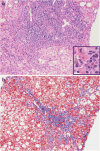Management of Difficult Cases of Autoimmune Hepatitis
- PMID: 26780632
- PMCID: PMC5410647
- DOI: 10.1007/s11894-015-0484-7
Management of Difficult Cases of Autoimmune Hepatitis
Abstract
Autoimmune hepatitis (AIH) is a complex autoimmune disease characterized by immune-mediated destruction of hepatic parenchyma which can result in cirrhosis, liver failure, and death. Current American Association for the Study of Liver Diseases (AASLD) and European Association for the Study of Liver (EASL) guidelines recommend corticosteroids alone or in combination with azathioprine as first-line treatment strategies. However, a significant proportion of patients may not be able to tolerate or achieve complete biochemical response with these options. In this article, we discuss approaches to these patients and other challenging AIH patient groups such as the asymptomatic, pregnant, elderly, and liver transplant recipients.
Keywords: Autoimmune hepatitis; Cirrhosis; Liver transplantation; Nonstandard treatment; Pregnancy; Refractory.
Conflict of interest statement
Conflicts of Interest
Craig Lammert reports grants from NIH, during the conduct of the study; Veronica M. Loy, Kiyoko Oshima, and Samer Gawrieh declare that they have no conflicts of interest.
Figures

References
-
- European Association for the Study of the Liver. EASL Clinical Practice Guidelines: Autoimmune hepatitis. J Hepatol. 2015 Oct;63(4):971–1004. Electronic address: easloffice@easloffice.eu. Most up to date, recently released national society AIH consensus statement aimed at providing diagnostic and therapeutic guidance for clinicians. Includes a wide collection of small observational AIH studies, few randomized controlled trails, and a large degree of expert opinion. - PubMed
-
- Heneghan MA, Yeoman AD, Verma S, Smith AD, Longhi MS. Autoimmune hepatitis. Lancet Lond Engl. 2013 Oct 26;382(9902):1433–44. - PubMed
-
- Waldenstrom J. Liver, blood proteins and nutritive protein. Dtsch Z Für Verdau- Stoffwechselkrankheiten. 1953;9:113–9. - PubMed
-
- Carbone M, Mells GF, Pells G, Dawwas MF, Newton JL, Heneghan MA, et al. Sex and age are determinants of the clinical phenotype of primary biliary cirrhosis and response to ursodeoxycholic acid. Gastroenterology. 2013 Mar;144(3):560–9.e7. quiz e13–4. - PubMed
Publication types
MeSH terms
Substances
Grants and funding
LinkOut - more resources
Full Text Sources
Other Literature Sources

